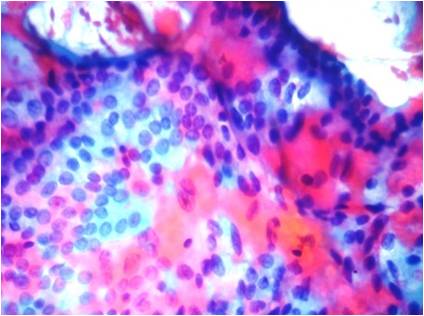Cytohistologic correlation study of Thyroid lesion: insight into the causes of discordance
Keywords:
FNAC, Thyroid, cytohistology correlation
Abstract
Background: Fine needle aspiration cytology (FNAC) is a popular diagnostic as well as therapeutic test in thyroid pathology. Like any other diagnostic modality, FNAC also has its limitations and pitfalls. This study was aimed at finding the causes for cytohistologic discordance, thereby minimizing the false positive and negatives.Methods: 1091 patients underwent thyroid FNA in a period of 2 years in our institute. Histopathological diagnosis was available in 313 cases. Data of these cases was collected and statistically analysed. Cases showing cytohistologic disparity were reevaluated to unmask the causes of discordance.Result: Of 313 cases with histopathological diagnosis, 19.48%(n=61) were neoplastic out of which 73.77%(n=45) were malignant. Mean age of study population was 42.48 years. 86.58% (n=271) were females. We found that sensitivity and specificity of FNA was 54.83% and 98.40% respectively. Positive predictive value was 89.47% and negative predictive value was 89.81%. Cytohistologic concordance was achieved in 89.78% of the cases. Of the discordant cases, false positive accounted for 1.2%(n=4) and false negative for 8.94%(n=28).Too much emphasis on cellularity and amount of colloid, failure to appreciate subtle nuclear features and sampling error were the most common causes for failure.Conclusion: Proper representative sampling, if needed guided by imaging modalities and meticulous examination of all the smears are the key points in reducing the number of discrepant cases.References
1. Somma J, Schlecht NF, Fink D, Khader SN, Smith RV, Cajigas A. Thyroid fine needle aspiration cytology: follicular lesions and the gray zone. Acta Cytol 2010;54:123-31.
2. Gharib H, Goellner J R. Fine-needle aspiration biopsy of the thyroid: An appraisal. Ann Intern Med 1993;118:282-9.
3. Sinna EA, Ezzat N. Diagnostic accuracy of fine needle aspiration cytology in thyroid lesions. Journal of the Egyptian National Cancer Institute 2012;24: 63–70
4. Hall TL, Layfield LJ, Philippe A, Rosenthal DL. Source of diagnostic error in the fine needle aspiration of the thyroid. Cancer 1989;63:718–25.
5 .Caraway NP, Sneige N, Samaan NA. Diagnostic pitfalls in thyroid fine-needle aspiration: A review of 394 cases. Diagn Cytopathol 1993;9:345-5
6. Ergete W, Abebe D. Discordance rate between thyroid fine needle aspiration cytology and histopathologic diagnosis. Ethiop J Health Dev 2002;16:227-31.
7. Bakhos R, Selvaggi SM, DeJong S, Gordon DL, Pitale SU, Herrmann M, et al. Fine-needle aspiration of the thyroid: Rate and causes of cytohistopathologic discordance. Diagn Cytopathol 2000;23:233-7.
8. Yeh MW, Demircan O, Ituarte P, Clark OH. False negative fine-needle aspiration cytology results delay treatment and adversely affect outcome in patients with thyroid carcinoma. Thyroid 2004;14:207-15.
9. Greaves TS, Olvera M, Florentine BD, Raza AS, Cobb CJ, Tsao-Wei DD, et al. Follicular lesions of thyroid: A 5 year fine-needle aspiration experience. Cancer 2000;90:335-41.
10. Bommanahalli BP, Bhat RV, Rupanarayan R. A cell pattern approach to interpretation of fine needle aspiration cytology of thyroid lesions: A cyto-histomorphological study. J Cytol. 2010; 27(4): 127–132.
11. Pandey P, Dixit A, Mahajan NC. Fine-needle aspiration of the thyroid: A cytohistologic correlation with critical evaluation of discordant cases. Thyroid Res Pract 2012;9:32-9
12. Suen KC. How does one separate cellular follicular lesions of the thyroid by fine needle- aspiration biopsy? Diagn Cytopathol 1988;4:78-81.
2. Gharib H, Goellner J R. Fine-needle aspiration biopsy of the thyroid: An appraisal. Ann Intern Med 1993;118:282-9.
3. Sinna EA, Ezzat N. Diagnostic accuracy of fine needle aspiration cytology in thyroid lesions. Journal of the Egyptian National Cancer Institute 2012;24: 63–70
4. Hall TL, Layfield LJ, Philippe A, Rosenthal DL. Source of diagnostic error in the fine needle aspiration of the thyroid. Cancer 1989;63:718–25.
5 .Caraway NP, Sneige N, Samaan NA. Diagnostic pitfalls in thyroid fine-needle aspiration: A review of 394 cases. Diagn Cytopathol 1993;9:345-5
6. Ergete W, Abebe D. Discordance rate between thyroid fine needle aspiration cytology and histopathologic diagnosis. Ethiop J Health Dev 2002;16:227-31.
7. Bakhos R, Selvaggi SM, DeJong S, Gordon DL, Pitale SU, Herrmann M, et al. Fine-needle aspiration of the thyroid: Rate and causes of cytohistopathologic discordance. Diagn Cytopathol 2000;23:233-7.
8. Yeh MW, Demircan O, Ituarte P, Clark OH. False negative fine-needle aspiration cytology results delay treatment and adversely affect outcome in patients with thyroid carcinoma. Thyroid 2004;14:207-15.
9. Greaves TS, Olvera M, Florentine BD, Raza AS, Cobb CJ, Tsao-Wei DD, et al. Follicular lesions of thyroid: A 5 year fine-needle aspiration experience. Cancer 2000;90:335-41.
10. Bommanahalli BP, Bhat RV, Rupanarayan R. A cell pattern approach to interpretation of fine needle aspiration cytology of thyroid lesions: A cyto-histomorphological study. J Cytol. 2010; 27(4): 127–132.
11. Pandey P, Dixit A, Mahajan NC. Fine-needle aspiration of the thyroid: A cytohistologic correlation with critical evaluation of discordant cases. Thyroid Res Pract 2012;9:32-9
12. Suen KC. How does one separate cellular follicular lesions of the thyroid by fine needle- aspiration biopsy? Diagn Cytopathol 1988;4:78-81.

Published
2016-12-20
Section
Original Article
Authors who publish with this journal agree to the following terms:
- Authors retain copyright and grant the journal right of first publication with the work simultaneously licensed under a Creative Commons Attribution License that allows others to share the work with an acknowledgement of the work's authorship and initial publication in this journal.
- Authors are able to enter into separate, additional contractual arrangements for the non-exclusive distribution of the journal's published version of the work (e.g., post it to an institutional repository or publish it in a book), with an acknowledgement of its initial publication in this journal.
- Authors are permitted and encouraged to post their work online (e.g., in institutional repositories or on their website) prior to and during the submission process, as it can lead to productive exchanges, as well as earlier and greater citation of published work (See The Effect of Open Access at http://opcit.eprints.org/oacitation-biblio.html).




